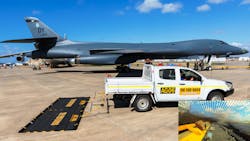FOD Removal Equipment to Clean Up the Airport
Even with the best intentions, practices and training, foreign object debris (FOD) happens. FOD is going to be found at the airport.
Once FOD is found, it needs to be removed.
According to the FAA, the most effective resource for FOD elimination is the use of FOD removal equipment, especially in areas where FOD can be expected, such as around aircraft replenishment zones and near areas of construction. For removal of an isolated piece of FOD detected on a runway, manual removal is the most efficient.
FAA Advisory Circular 150/5210-24 places FOD removal equipment into two categories: mechanical systems and non-mechanical systems.
Mechanical systems include:
- Power sweepers – Remove debris from cracks and pavement joints. Sweepers include tow-behind bristle trailers and are typically used in all areas of the air operations area (AOA). For all brush systems, the FAA cautions that bristles can detach and become a source of FOD. Plastic or combination plastic/metal bristles may be appropriate, but the equipment manufacturer should be contacted for specific recommendations. Regardless of the equipment used, a thorough check of the pavement should be conducted at the conclusion of the sweeping procedure.
- Vacuum systems – Use airflow as primary means of object retrieval.
- Jet air blowers – Remove debris by directing a stream of high velocity air towards the pavement. When used at an airport, utilization of a debris collection mechanism is recommended.
Non-mechanical systems include:
- Friction mat sweepers – Towed behind vehicles, including electric vehicles, employ a series of bristle brushes and friction to sweep FOD into sets of capture scoops, which are covered by a retaining mesh to hold collected debris.
- Magnetic bars attached to vehicles – Can be suspended beneath tugs and trucks to pick up metallic material. The bars should be cleaned regularly to prevent them from dropping the collected debris.
- Rumble strips (FOD shakers) – Positioned on the pavement to dislodge FOD from vehicles that drive over them. The equipment can generate its own FOD if not cleaned out regularly. According to the FAA, the current best practice for removing FOD from tires is to stop a vehicle at a designated checkpoint, perform a visual inspection, then use a hand tool to manually remove detected debris.
Here are a few examples of specific FOD removal technologies:
FOD*BOSS Ultimate Airport Sweeper
FOD*BOSS Ultimate Airport Sweeper from Aerosweep can be connected to any electric or fuel-powered vehicle equipped for towing and deployed in minutes. FOD such as stones, sand, metallic objects, nuts and bolts, can be swept up from tarmac surfaces at speeds up to 40 mph. The biggest boss of the FOD*BOSS is the 24-foot-wide FOD*BOSS Triplex Sweeper System, which can sweep an area of 5.1 million square feet in an hour. The Triplex can be operated as a Duplex sweeper and a Single sweeper or as three independent single sweepers.
The FOD*BOSS has several patented features. The Debris Retention Intake Blade, which consists of the Triple Elevator Steps that critically hold the FOD that hasn’t yet made it up the scoop’s face, and prevents it from sliding back down onto the tarmac during a deceleration phase. It also includes the Debris Retention Barrier, which keeps debris secure within the FOD capture zones. While FODStop Barriers prevent the escape of FOD from the side of the sweeper during cornering maneuvers.
The GroundForce Tow Hitch keeps the FOD*BOSS on the ground, enabling the higher sweep speeds sweeping in headwinds, and ensures the sweeper tracks are straight.
To assist FOD prevention efforts, the FOD*BOSS Sweep Tracker iOS and Android App allows data gathering.
Elgee Power Vac
The Elgee Power Vac (gasoline or propane-powered) provides up to 40 inches of surface cleaning, powerful suction to extract debris from crevices, a gets into tight-to-reach areas with an attached hose. A magnetic bar assembly separates out metallic objects while the brush assembly, mounted in the front of the vacuum, loosens debris. The Instant Action Hose reaches into corners, tight areas, crevices and grates. No stopping the engine or special hose wand hook-up is required, just retrieve the hose wand from the on-board holster and position the nozzle where needed. Debris in cracks and crevices can be dangerous. With that in mind, the Crack Funnel provides increased vacuum suction.
AF1 EVO Cold Air Blower
The AF1 EVO from RPM Tech is used for clearing snow and ice around runway lighting. The burst of air moves the materials away from the lighting without damaging them while performing winter maintenance operations. Airports can also adopt the blowers to remove dust, debris, FOD and other foreign objects on the runway. The third series upgrades include a three-stage centrifugal high-performance blower driven by a diesel engine and provides an air speed of up to 535 mph. The blower module has its own fuel tank and provides up to eight hours of fuel autonomy during operation.
About the Author
Rebecca Kanable
Assistant Editor
Rebecca Kanable, a veteran journalist, worked with Endeavor Business Media's aviation group from 2021 to 2024 as assistant editor of Airport Business, AMT and Ground Support Worldwide. She previously worked for various publications, including trade magazines and newspapers.

